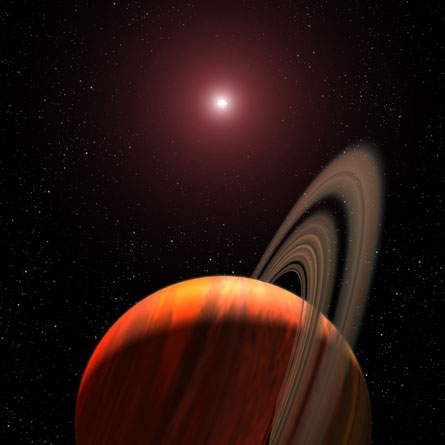- More than 2 years ago
Want to make a planet that can sustain carbon-based life? Don’t park it in orbit around a sunlike star.

“For the long term, the sun may not be the best star,” says Edward Guinan of Villanova University in Pennsylvania, coauthor of a paper reporting a new model about the suitability of planets for life. Smaller, cooler stars called orange dwarf stars might be the most hospitable, he says.
Guinan and two colleagues compared the ultraviolet and X-ray emissions of different types of stars and computed the damage this output could do to DNA, as a proxy for carbon-based life. The team presented the results in August at the International Astronomical Union meeting in Rio de Janeiro and also in a paper published online November 10 at arXiv.org.
The researchers used theoretical models and archived data from the now-inoperative International Ultraviolet Explorer satellite to determine the amount of ultraviolet and X-ray radiation in different stars’ habitable zones, areas around stars where temperatures are right for an orbiting planet to have liquid water.
They found that stars slightly larger and hotter than Earth’s sun were the worst offenders in terms of near-ultraviolet radiation, contributing five times more damage to DNA than would sunlike stars. Near-ultraviolet radiation is slightly more energetic than visible light.
“This is the type of radiation that has biggest potential for producing biological damage,” says lead author Manfred Cuntz of the University of Texas at Arlington. “X-rays are in many cases very effectively shielded by the atmosphere of a planet. Ultraviolet has a greater chance of sneaking through.”
The next highest near-ultraviolet emitters were sunlike, followed by two classes of smaller stars, orange dwarfs and red dwarfs. Red dwarf stars, also called M dwarf stars, have recently received a lot of attention as the best candidates for finding Earth-sized planets (SN: 12/20/08, p. 16), partially because the stars are so small.
But M dwarf stars have other problems. Their high surface magnetic fields dump energy into their outer layers, heating the gas there and producing stellar flares. This behavior is especially common in young stars, which spin faster and therefore have a stronger magnetic dynamo. Flares cause a spike in ultraviolet radiation and in X-rays, both of which, over time, can strip away a planet’s atmosphere.
M dwarf stars are also so dim that their habitable zones are close enough to keep most planets tidally locked, meaning that one side of the planet faces the star at all times.
That’s not necessarily a problem: The dark side of the planet and some regions in permanent twilight could be habitable. “You have such a range of temperatures that somewhere the temperature is right for life,” comments Frank Drake of the SETI Institute.
But a planet needs its own magnetic field for protection from its host star’s wild outbursts. Many scientists think rapidly spinning liquid cores are necessary for planetary magnetic fields. Tidally locked planets might spin too slowly for a magnetic field to persist, leaving its atmosphere vulnerable.
“The bottom line is, if the planet doesn’t have a magnetic field and it’s near a star … the winds and the X-rays erode away the whole atmosphere of the planet,” Guinan says, no matter what type of star.
The “Goldilocks stars” with just the right conditions might be K-type stars, or orange dwarfs, Guinan says. These stars put out less near-ultraviolet energy than sunlike stars, are less likely to flare up than M dwarf stars, and have a habitable zone far enough away that planets in that zone are unlikely to be tidally locked.
K-type stars also live five to six times longer than the sun, giving life more time to develop, Guinan’s team reasons. They’re also more common than suns, making up about 15 percent of the stars in the galaxy. Checking them for signs of life might just be playing the numbers, Guinan says.
“Given all the unknowns, it’s a good starting point,” says Sara Seager of MIT. But she adds that “observers will never miss an opportunity to see something interesting just because a theorist says it’s a bad place for life.”







